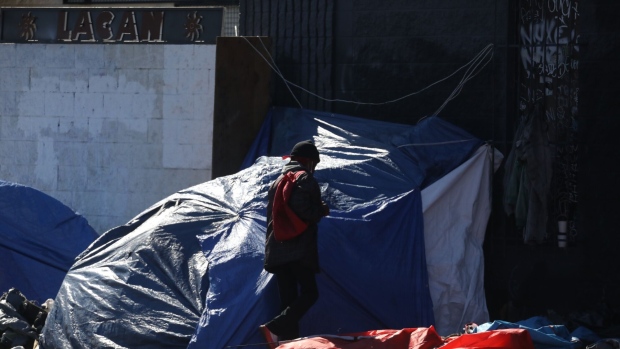Jun 28, 2024
LA Homeless Count Sees Small Drop as More People Put In Motels
, Bloomberg News

(Bloomberg) -- The homeless population in Los Angeles County declined slightly, a sign that policies and emergency directives put into place by state and local officials are showing some signs of progress.
The number of unhoused people fell 0.3% from 2023, the first drop since 2018, with an estimated 75,312 people living on the street or in temporary shelters, according to the annual estimate from the Los Angeles Homeless Services Authority released on Friday.
Within the Los Angeles city limits, the count showed that the number of people experiencing homelessness fell 2.2%, bringing the total down to 45,252.
“This is not victory,” LA County Supervisor Lindsey Horvath said at a briefing. “It is validation — validation that our strategy is working and now we must double down.”
While data shows a drop in the overall number of homeless people, it also found a significant rise in people living temporarily in hotels and motels as part of Los Angeles Mayor Karen Bass’s signature Inside Safe program. That means there are more homeless people in shelters but fewer on the streets.
“This is a milestone for Los Angeles,” Bass said at the briefing. “We’ve moved LA in a new direction and we can say that homelessness is down.”
The survey was conducted in late January by thousands of volunteers across the 4,000 square miles of Los Angeles County. They traveled in small groups, tallying the number of unsheltered individuals, tents, vehicles and makeshift shelters they saw in assigned census tracts. Researchers also surveyed thousands of homeless people to gather demographic information.
Leaders in Los Angeles and California have been grappling with a seemingly unmanageable homeless crisis since the 1980s when the county’s overall population soared, affordable housing development stalled and makeshift encampments first began to pop up under downtown freeway overpasses. The growing emergency has been magnified of late by soaring rents in the wake of the pandemic.
However, recently implemented government policies have led to a gradually expanding inventory of affordable homes, temporary and supportive housing, and rental assistance programs that have helped to curb the tide of homelessness.
The US Supreme Court on Friday ruled that cities can enforce bans on homeless people sleeping outdoors. It overturned an appeals court decision that the bans were unconstitutional, a ruling that applied to California and other Western states.
The latest report marks only the second time since 2015, the year before the city and county began spending heavily on homelessness services and permanent housing, that Los Angeles has seen its homeless population decline on a year-over-year basis.
In 2016, voters in Los Angeles approved a $1.2 billion bond measure, Proposition HHH, to develop permanent, rent-stabilized housing for those most in need of supportive services. While the city struggled to produce a consequential amount of permanent housing during the early years of the measure, officials now say they’re on track to exceed its initial goal of building 10,000 housing units in 10 years.
Voters also approved a quarter-cent county sales tax for homelessness projects in 2017, which sunsets in three years. A push to replace that tax with a permanent half-cent levy is currently underway. The coalition of proponents for the half-cent sales tax includes more than 80 organizations, including the L.A. County Federation of Labor, United Way of Greater Los Angeles and Service Employees International Union Local 721.
Another source of funding came in 2022 when Los Angeles City voters approved a so-called “mansion tax” to raise money for homeless shelters and services. It charges transfer fees of 4% on property sales of $5 million to $10 million, and 5.5% on sales greater than $10 million. The measure generated about $200 million in its first year, far below pre-election estimates as high as $900 million of annual revenue.
Campaign Promise
As the number of unhoused people began to rise significantly during the pandemic, Angelinos started asking why there hasn’t been more to show for so much taxpayer investment.
Bass, the mayor, campaigned in 2022 on a promise to rein in homelessness and declared a state of emergency shortly after taking office. She issued an executive directive to fast-track land-use approval for affordable-housing development and launched Inside Safe, which is designed to clear street encampments by moving unhoused people into motels and hotels.
While the homeless count rose 9% during her first year in office, her policies now appear to be taking hold.
On the statewide level, Governor Gavin Newsom has also made the homelessness crisis a priority. Despite fierce opposition from civil rights organizations, he fought to set up the state’s new CARE Court system, a parallel judicial system that can mandate treatment for those experiencing severe untreated mental illness. Eight counties began implementing their CARE Courts in October 2023.
Additionally, Newsom asked voters in California to approve more funding for homelessness services and housing during the March Primary. The statewide $6.4 billion measure, Proposition 1, barely passed with a simple majority despite the governor’s backing.
Newsom invested political capital on Prop 1, angling to make sure it stood alone as the only statewide bond proposition on the March ballot.
--With assistance from John Gittelsohn and Ali Juell.
©2024 Bloomberg L.P.






